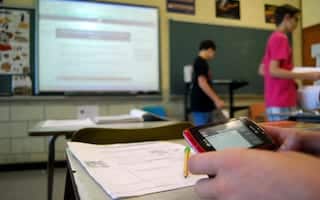Table of Contents
Universal Design for Learning (UDL) truly supports personalized learning
by Martin McKay
Personalized learning has been a much-discussed topic in education for the last few years. The term is everywhere. And it’s very persuasive. It hopes to address learner variability and to make education more accessible for different learners. But, there’s nothing new about personalized learning, either as an aspiration or a practice. It’s an approach that’s as old as the hills.
Understanding Universal Design for Learning
Over the last couple of years, it has become well recognized by US educators that Universal Design for Learning (UDL) is the perfect pedagogical approach that truly supports the idea of personalized learning.
“Universal Design for Learning (UDL) is a framework to improve and optimize teaching and learning for all people based on scientific insights into how humans learn.”
www.cast.org
You can determine each learner’s needs by using the principles of UDL to understand their strengths, challenges, aptitudes, interests, talents, and aspirations. UDL has often been connected to special educational needs, but it is a framework that applies to ALL learners who have variability in their learning. UDL helps teachers understand all the learners in their classroom. Every student brings something different and has different strengths.
New Tools for Variability
 As UDL tells us, when we are designing for student variability, it is important to provide students with a few ways to demonstrate their knowledge and keep the lesson or content interesting for everyone. New technologies have revolutionized how students learn and allow for that multiple means of expression. Portable, personal laptops like Chromebooks or Surface Pros with stylus and touch interfaces, great computing power, and cloud connectivity make it possible to tailor learning to personal interests and needs, even allowing for 1:1 initiatives where each student has their own device to support their learning.
As UDL tells us, when we are designing for student variability, it is important to provide students with a few ways to demonstrate their knowledge and keep the lesson or content interesting for everyone. New technologies have revolutionized how students learn and allow for that multiple means of expression. Portable, personal laptops like Chromebooks or Surface Pros with stylus and touch interfaces, great computing power, and cloud connectivity make it possible to tailor learning to personal interests and needs, even allowing for 1:1 initiatives where each student has their own device to support their learning.
In the past few years, students can now turn in homework that includes photos, video, audio, animations, interactive graphics, smart maps, and presentations.
Having and using technology in teaching and learning isn’t enough though. Making the most of technology requires a methodical and principled approach, one that turns the aspirations of personalized learning into an effective practice of personalized learning. Universal Design for Learning makes that practice possible.
Strategies to Address Learner Variability
 Providing the tools, diverse activities and scaffolded content to meet each learner’s unique needs can feel daunting. It’s important to start small with one new practice or strategy and then build on that. There are a number of tools that teachers can explore that can help to address learner variability. Here are just a couple of examples:
Providing the tools, diverse activities and scaffolded content to meet each learner’s unique needs can feel daunting. It’s important to start small with one new practice or strategy and then build on that. There are a number of tools that teachers can explore that can help to address learner variability. Here are just a couple of examples:
- Collaborate – Some days we work better together. Get students to work together on Google Slides or Microsoft PowerPoint. Maybe one works on content, and one on design if that is where their strengths lie.
- Sketchnoting – Some students can adopt visual note-taking to support information recall and build understanding. The new stylus and touch devices are great for this.
- Overcoming Shyness – Use the comments stream inside Google Docs or Word to converse with shy students privately.
- Audio recording – Kids can practice and demonstrate oral reading fluency by attaching an audio recording to a turned in homework.
- Text-to-Speech -Some students may feel more comfortable hearing passages of text read aloud
Meeting Students Where They Are
 Personalizing instruction and the use of technology in the classroom does not mean there is less of a place for teacher-led instruction. It also doesn’t mean that teachers need to spend endless time after school each day creating an individualized lesson for each and every student in the class. It’s all about meeting students in the spaces where they are and helping them grow by providing diverse ways for them to engage in learning, process content, and show their understanding.
Personalizing instruction and the use of technology in the classroom does not mean there is less of a place for teacher-led instruction. It also doesn’t mean that teachers need to spend endless time after school each day creating an individualized lesson for each and every student in the class. It’s all about meeting students in the spaces where they are and helping them grow by providing diverse ways for them to engage in learning, process content, and show their understanding.
Every child’s different, with their own star qualities, strengths, challenges and learning styles. Their needs are vast, and there are a multitude of ways teachers can meet those needs effectively in class as well as for independent study and learning at home.
Want to Learn More?
Listen to Martin McKay CTO and founder of Texthelp along with special guest Kathleen McClaskey, founder of Make Learning Personal; co-founder of Personalize Learning, LLC; co-author of Make Learning Personal and How to Personalize Learning in a pre-recorded session on How to Personalize Learning and Maximize Achievement for All Students.
Author Martin McKay founded Texthelp in 1996 to help people with communication difficulties. What started as a company focused on people with profound Speech and Dexterity Disabilities has become a world-leading Education Technology company providing easy-to-use and useful software tools that help everyone read, write, and communicate with clarity in education, at work and in life.
Martin McKay founded Texthelp in 1996 to help people with communication difficulties. What started as a company focused on people with profound Speech and Dexterity Disabilities has become a world-leading Education Technology company providing easy-to-use and useful software tools that help everyone read, write, and communicate with clarity in education, at work and in life.
Over that time he has built, led and directed a team of engineers to deliver technology that is used by millions of people every day around the world. He regards himself as incredibly fortunate to work in a sector that has such a positive impact on society using technologies that are so fun and compelling with work with. Martin is currently serving in an advisory capacity on the Universal Design for Learning council in the US.
Most importantly of all, Martin and Texthelp believe that everyone’s entitled to the best possible learning and language support on their own personal journey – from literacy to life.
Follow Martin on Twitter.
Further Reading
- Andover Townsman – First half of school year marked by innovation, teamwork
- EdSurge – Where Does Personalized Learning End and Special Education Begin?
- PRWeb – Learnosity Welcomes Desmos, TextHelp, and GeoGebra to its Global Partner Network



